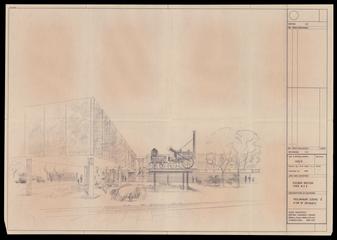
Museum of British Transport, Clapham
Prior to the nationalisation of the railways in 1948, the Great Western Railway (GWR), the London, Midland and Scottish Railway (LMS), the London and North Eastern Railway (LNER) and the Southern Railway (SR) had preserved some relics relating to their history and in some cases these relics had been held at museums at railway works such as Crewe. These relics were inherited by the British Transport Commission and in 1951 they appointed J.H. Scholes was appointed as the BTC's ‘Curator of Historical Relics’, whose remit was selecting and preserving the heritage of all the nationalised transport industries, including buses, railways, waterways, docks, tramways, and road haulage. A collecting policy was implemented to grow the nation's collection of railway artefacts and bring together the historical railway material formerly held by the railway companies prior to nationalisation. During the 1950s J.H. Scholes mounted itinerant displays of material whilst a suitable museum site was being found. In 1955 there was an attempt to open a museum at a site in Brighton, although this was unsuccessful.
In 1958 the Consultative Panel for the Preservation of British Transport Relics was formed with Alfred Boston as Chairman and included members from prominent preservation societies as well as featuring J.H. Scholes as the Clapham museum's representative. The Panel was formed in an effort stop relics earmarked for preservation being scrapped and to counter the view taken by some senior railway managers that retaining models of significant locomotives was preferable to preserving the actual locomotives.
After operating out of railway offices in Euston and Porchester Road, a site was found for the Museum of British Transport in a former bus garage in Clapham and the museum opened its doors on 29th March 1961 with a gallery displaying small objects. It expanded two years later with the opening of the main gallery on 29th May 1963 that housed the museum's large objects including rail vehicles. The site did not have a rail link but was located near to Nine Elms works and relics could be transported to the museum by road from a rail head there.
The Museum for British Transport was at the centre of a network of satellite and associated museums that the BTC either operated directly or opened with enthusiast and local authority partners. The London & North Eastern Railway (Queen Street) Museum in York had been in railway hands since 1927. In 1962 British Railways' Western Region worked with Swindon Council to open a museum focusing on the heritage of the Great Western Railway, it is known as Steam: Museum of the Great Western Railway. In 1963 the National Tramways Museum was opened in partnership with the Tramways Museum Society in Crich, part of the BTC's tram collections and a collections store at Clay Cross was transferred to the new museum. A Museum of Transport was opened alongside the local authority and enthusiasts in Glasgow (now known as the Riverside Museum) in 1964 with a geographical focus on Scottish relics. The Canal Museum in Stoke Bruerne was opened in 1965 by an enthusiast group and the BTC, the waterways material held at Clapham were transferred on the museum's opening to displayed in their original waterside context. The collections held at Stoke Bruerne may have since moved to the National Waterways Museum in Ellesmere Port and the Gloucester Waterways Museum after these museums opened in 1976 and 1988, respectively. These three museums came to be operated by the British Waterways Board (BWB), a successor to the BTC's Docks and Inland Waterways Executive and latterly by the BWB's successor body, the Canal & River Trust, a charitable organisation.
The Clapham Museum seems to have struggled financially throughout its existence, operating at a loss of £30,000 a year in 1968 and eventually closed in 1973. The 1968 Transport Act transferred responsibility for the BTC's Historical Relics to the British Railways Board and proposed that the Clapham and existing museum in York be closed and amalgamated into a new museum. This functioned as a catalyst for BR to work with the Science Museum to develop a National Railway Museum to house the extensive railway collections. The years preceding Clapham's closure contained much debate over proposals for keeping its collections intact, finding suitable homes for the various collections and the location of any resulting new museums. The Paymaster General and Minister for Arts, Lord Eccles, decided that Clapham's railway collections should be transferred to the Board of Trustees of the Science Museum and displayed at a new National Railway Museum (NRM) on Leeman Road in York. The Clapham Museum closed its doors on 23 April 1973. The NRM was opened in 1975 and J.H. Scholes was appointed as Curator of the new museum, although he did not assume the post. The old York Railway Museum on Queen Street had closed its doors at the end of 1973 and its collections transferred to the Leeman Road site. The collections that related to London's transport network were transferred to Syon Park, West London in 1973 as the London Transport Collection under the care of London Transport. Subsequently these collections were transferred to the London Transport Museum which opened with a charitable organisation as their parent body in Covent Garden in 1980. Road haulage relics were dispersed to suitable local museums.